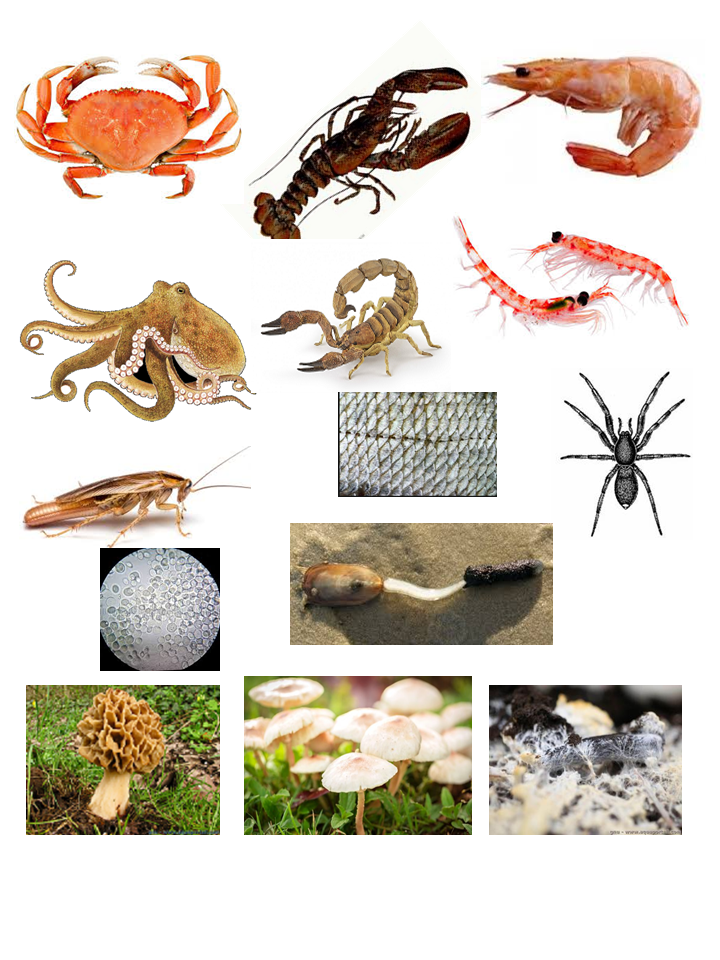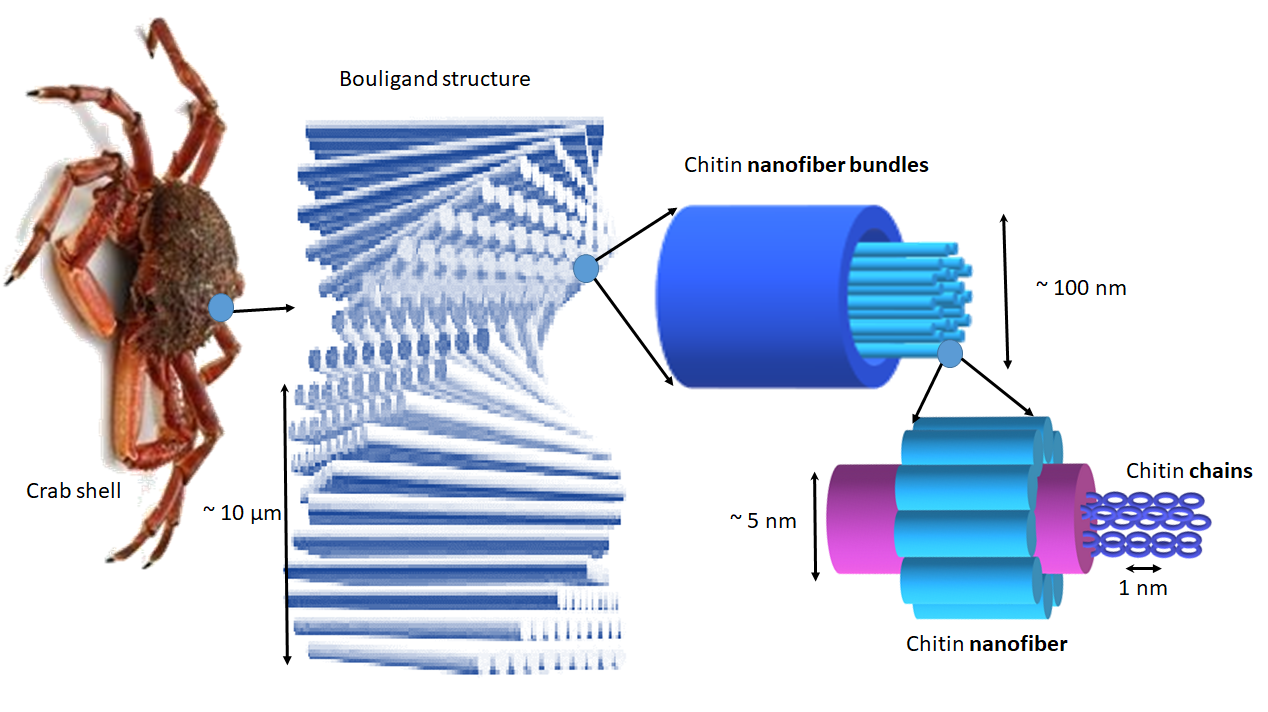Chitin (β-1,4-linked 2-acetamido-2-deoxy-D-glucose) is found throughout the biosphere. Its estimated production is 1010 to 1012 tons per year. Chitin is the second most abundant polymer after cellulose. Sea animals, insects, and micro-organisms are the sources of chitin. In more than 90% of all animal species and insects, chitin-based composites are the major constituents of the exoskeletons of arthropods. This is the case of crustaceans (crabs, lobster, and shrimps) and insects as well for the radulae of mollusks, cephalopods beaks, and the scales of fish and lissamphibian.

Figure 2. Sources of chitin and chitosan. • Sea animals: Crustaceans, Coelenterata, Annelida, Mollusca, Lobster, Shrimp Prawn, Krill, Crab. Fish-scales; • Insects: Scorpion, Brachiopod, Cockroach, Spider, Beetle, Ant; • Microorganisms: Green algae, Yeast, Fungi (cell wall), Mycelia penicillium, Brown algae, Chytridiaceae, Ascomycetes, Blastocladiaceae, Spores.
The exoskeletons of crustacean provide firm support and protection to the soft tissues of these animals. They are not only composed by chitin, as other proteins occur, including an elastic rubber-like substance called resilin, which is an intrinsically disordered protein. The identity and nature of these proteins determine whether the exoskeleton will be rigid, like a beetle’s shell, or soft and flexible like the joints of a crab leg. Non-protein compounds are found such as calcium carbonate, that determines whether the exoskeleton is rigid, or soft and flexible. They form structurally and mechanically graded biological nanocomposites.
In fungi, chitin is a major constituent of the supramolecular network formed by structural polysaccharides and proteins outside the plasma membrane. Chitin is an important structural building block of the fungal cell wall. It has a role in the plant innate immunity in the microbe-associated molecular patterns (MAMPs). Several plant receptors for chitin have been characterized as well as different strategies adopted by fungi to evade chitin recognition. Despite its strong activity as an elicitor of plant defense chitin represents only a small percentage of the cell wall of most fungi compared to other complex sugars. β-glucan, to which chitin and chitosan may be bound.
The partial or complete de-N-acetylation of chitin, under alkaline conditions, yields chitosan, which contains varying amounts of GlcNAc and D-Glucosamine (GlcN) units. Chitosan, is a polycation and is found less frequently in the bio-sphere and is associated with some fungal cell walls and green algae. Chitosan is a random copolymer with a fraction of β-(1→4)-N-acetyl-D-glucosamine and a fraction (1-DA) of β-(1→4)-D-glucosamine.

The exoskeleton material of arthropods consists of mineralized fibrous chitin-based tissue, which follows a strict hierarchical organization over several order of magnitudes, ranging from the millimeter to the nanometer range. Nanofibrills having dimensions of about 2-5 nm diameter and about 300 nm lengths are formed by the side-by-side arrangement of 18-25 chitin chains, wrapped by proteins. The next step of organization results from the clustering of these nano-fibers to form long chitin-protein microfibrils of about 50-300 nm diameter. They are further organized and form a planar woven and periodically branched network in the form of chitin-protein layers. Proteins and biominerals (essentially in the form of microcrystalline CaCO3) fill the spacing between the fibers).The helicoidal stacking sequence of the fibrous chitin-protein layers constitutes the following meso-scale level of overall hierarchy. This is referred to as a twisted plywood or Bouligand pattern. This structure is formed by the helicoidal stacking sequence of the fibrous chitin-protein layers (translation and rotation). This determines a stacking density of planes which are gradually rotated about their arrangement with respect to the normal axis, Typically, about 20 layers of chitin-protein layer constitute one pitch of the helical arrangement.
A critical evaluation of potential sources of chitin and chitosan (Allan et al., 1978) concluded that shrimp, prawn, and crab waste were the principal source of chitin and chitosan and would remain so for the immediate future. However, it was envisaged that both Antarctic krill and cultured fungi would complement these major sources of raw materials.
